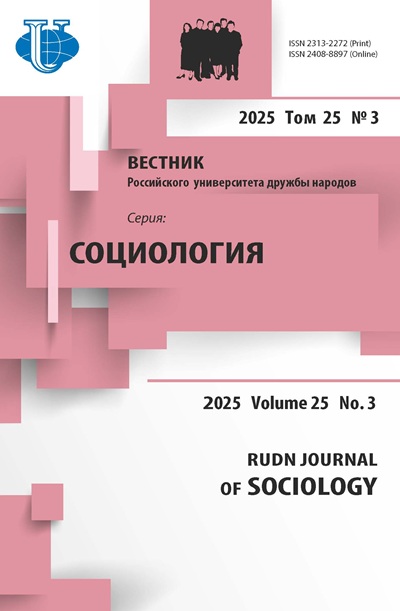Некоторые последствия изменений в распределении населе-ния мира: насколько глобализированным останется мир?
- Авторы: Зинькина Ю.В.1,2, Шульгин С.Г.1, Алешковский И.А.2, Андреев А.И.2
-
Учреждения:
- Российская академия народного хозяйства и государственной службы при Президенте Российской Федерации
- Московский государственный университет им. М.В. Ломоносова
- Выпуск: Том 18, № 2 (2018)
- Страницы: 271-283
- Раздел: Современное общество: актуальные проблемы и перспективы развития
- URL: https://journals.rudn.ru/sociology/article/view/18453
- DOI: https://doi.org/10.22363/2313-2272-2018-18-2-271-283
- ID: 18453
Цитировать
Полный текст
Аннотация
Об авторах
Юлия Викторовна Зинькина
Российская академия народного хозяйства и государственной службы при Президенте Российской Федерации; Московский государственный университет им. М.В. Ломоносова
Email: juliazin@list.ru
кандидат исторических наук, старший научный сотрудник Международной лаборатории демографии и человеческого капитала Российской академии народного хозяйства и государственной службы при Президенте Российской Федерации; стажер-исследователь факультета глобальных процессов Московского государственного университета имени М.В. Ломоносова Ленинские горы, 1-51, Москва, 119991, Россия
Сергей Георгиевич Шульгин
Российская академия народного хозяйства и государственной службы при Президенте Российской Федерации
Email: sergey@shulgin.ru
кандидат экономических наук, заместитель заведующего Международной лабораторией демографии и человеческого капитала Российской академии народного хозяйства и государственной службы при Президенте Российской Федерации Просп. Вернадского, 84, Москва, 119571, Россия
Иван Андреевич Алешковский
Московский государственный университет им. М.В. Ломоносова
Email: aleshkovski@fgp.msu.ru
кандидат экономических наук, заместитель декана факультета глобальных процессов Московского государственного университета имени М.В. Ломоносова Ленинские горы, 1-51, Москва, 119991, Россия
Алексей Игоревич Андреев
Московский государственный университет им. М.В. Ломоносова
Email: andreev@fgp.msu.ru
кандидат биологических наук, заместитель декана факультета глобальных процессов Московского государственного университета имени М.В. Ломоносова Ленинские горы, 1-51, Москва, 119991, Россия
Список литературы
- Apt W. Germany's New Security Demographics: Military Recruitment in the Era of Population Aging. Springer Science & Business Media; 2013.
- Borgatti SP., Everett MG., Johnson JC. Analyzing Social Networks. Sage Publications; 2013.
- Castells M. The Information Age: Economy, Society, and Culture. Vol. I: The Rise of the Network Society, Wiley-Blackwell; 1996.
- Castells M. Information Technology, Globalization, and Social Development. Geneva: United Nations Research Institute for Social Development; 1999.
- Castells M. The Rise of the Network Society: The Information Age: Economy, Society, and Culture (Vol. 1). John Wiley & Sons; 2011.
- Candau F. Trade, FDI and Migration. International Economic Journal. 2013: 27(3): 441-461.
- Chase-Dunn C., Kawano Y., Brewer B. Trade globalization since 1795: Waves of integration in the world-system. American Sociological Review. 2000: 65 (1): 77-95.
- Coleman D., Rowthorn R. Who’s afraid of population decline? A critical examination of its consequences. Population and Development Review. 2011: 37 (1): 217-248.
- Ernst & Young. Looking beyond the Obvious. Globalization and New Opportunities for Growth. About the 2012 Globalization Index. 2012. http://www.ey.com/GL/en/Issues/Driving-growth/Globalization---Looking-beyond-the-obvious---2012-Index.
- Goldstone J.A., Kaufmann E.P., Toft M.D. (Eds.). Political Demography: How Population Changes are Reshaping International Security and National Politics. Oxford University Press; 2012.
- Goldstone J.A., Marshall M.G., Root H. Demographic growth in dangerous places: Concentrating conflict risks. International Area Studies Review. 2014: 17 (2): 120-133.
- Grinin L.E., Korotayev A.V. Social macroevolution: Growth of the world system integrity and a system of phase transitions. World Futures. 2009: 65 (7): 477-506.
- Grinin L.E., Korotayev A.V. Will the global crisis lead to global transformations? 1. The global financial system: Pros and cons. Journal of Globalization Studies. 2010: 1 (1): 70-89.
- Kim T., Sciubba J.D. The effect of age structure on the abrogation of military alliances. International Interactions. 2015: 41 (2): 279-308.
- Korotayev A., Zinkina Yu. How to optimize fertility and prevent humanitarian catastrophes in Tropical Africa. African Studies in Russia. 2014: 6: 94-107.
- Korotayev A., Zinkina Yu. East Africa in the Malthusian trap? Journal of Developing Societies. 2015: 31 (3): 385-420.
- Korotayev A., Zinkina Yu., Andreev A. Secular cycles and millennial trends. Cliodynamics. 2016: 7 (2): 204-216.
- Korotayev A., Zinkina Yu., Goldstone J., Shulgin S. Explaining current fertility dynamics in Tropical Africa from an anthropological perspective: A cross-cultural investigation. Cross-Cultural Research. 2016: 50 (3): 251-280.
- Modelski G. Globalization as evolutionary process. In: Modelski G., Devezas T., Thompson W.R. (Eds.). Globalization as Evolutionary Process: Modeling Global Change. London-New York: Routledge; 2008. P. 11-29.
- Sciubba J.D. The Future Faces of War. Population and National Security; Santa Barbara: Praeger; 2011.
- Shulgin S., Zinkina Yu., Andreev A. Method of analysis of the global trade network structure. Ekonomika i Upravlenie: Provlemy, Resheniya. 2016: 12: 48-56 (In Russ.).
- Shulgin S., Zinkina Yu., Andreev A. Measuring globalization: Network approach to countries’ global connectivity rates and their evolution in time. Social Evolution and History. 2018 (forthcoming).
- Teitelbaum M.S. Political demography: Powerful trends under-attended by demographic science. Population Studies. 2015: 69: 87-95.
- United Nations, Department of Economic and Social Affairs (UN DESA), Population Division. World Population Prospects: The 2017 Revision. https://esa.un.org/unpd/wpp.
- United Nations. UN Comtrade Database. 2017. https://comtrade.un.org.
- United Nations. International Migrant Stock by Destination and Origin. 2015.
- Weiner M., Russell S.S. (Eds.). Demography and National Security. Berghahn Books; 2001.
- World Bank. Trade in Services Database. 2017 https://data.worldbank.org/data-catalog/trade-in-services.
- Yoshihara S., Sylva D.A. (Eds). Population Decline and the Remaking of Great Power Politics. Potomac Books; 2012.
- Zinkina Yu., Korotayev A. Explosive population growth in tropical Africa: Crucial omission in development forecasts - emerging risks and way out. World Futures. 2014: 70 (2): 120-139.
- Zinkina Yu., Korotayev A. Projecting Mozambique’s demographic futures. Journal of Futures Studies. 2014: 19 (2): 21-40.
- Zinkina Yu., Korotayev A., Andreev A. Measuring globalization: Existing methods and their implications for teaching global studies and forecasting. Campus-Wide Information Systems. 2013: 30 (5): 321-339.
Дополнительные файлы













